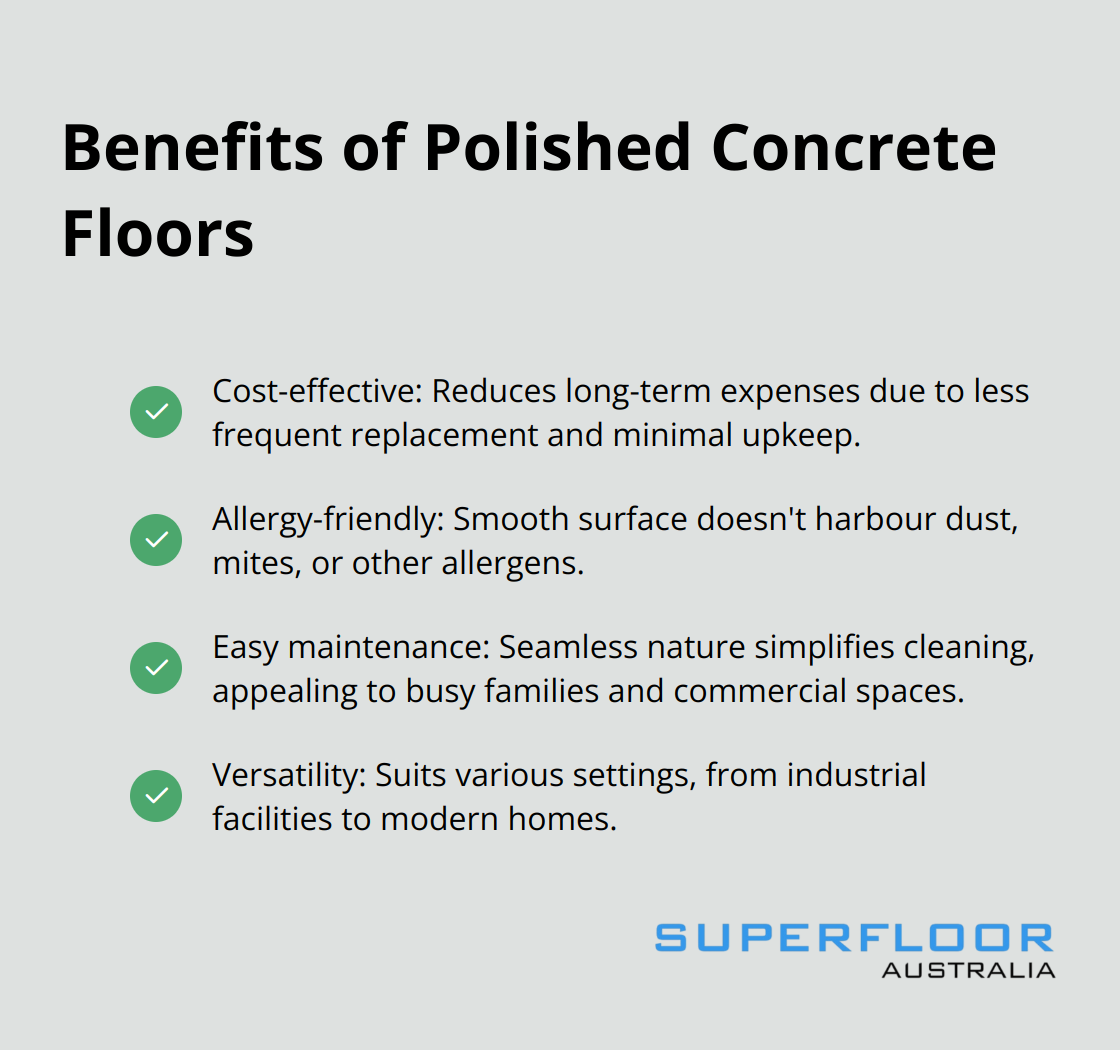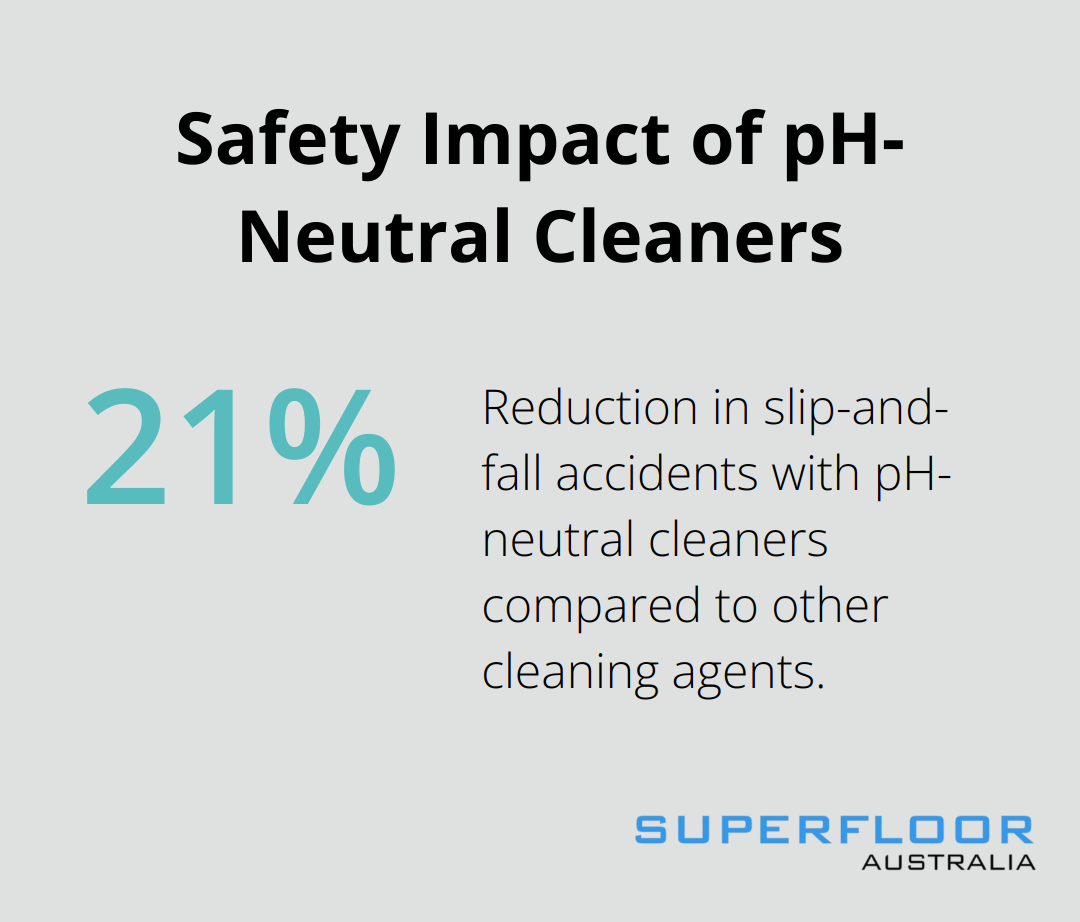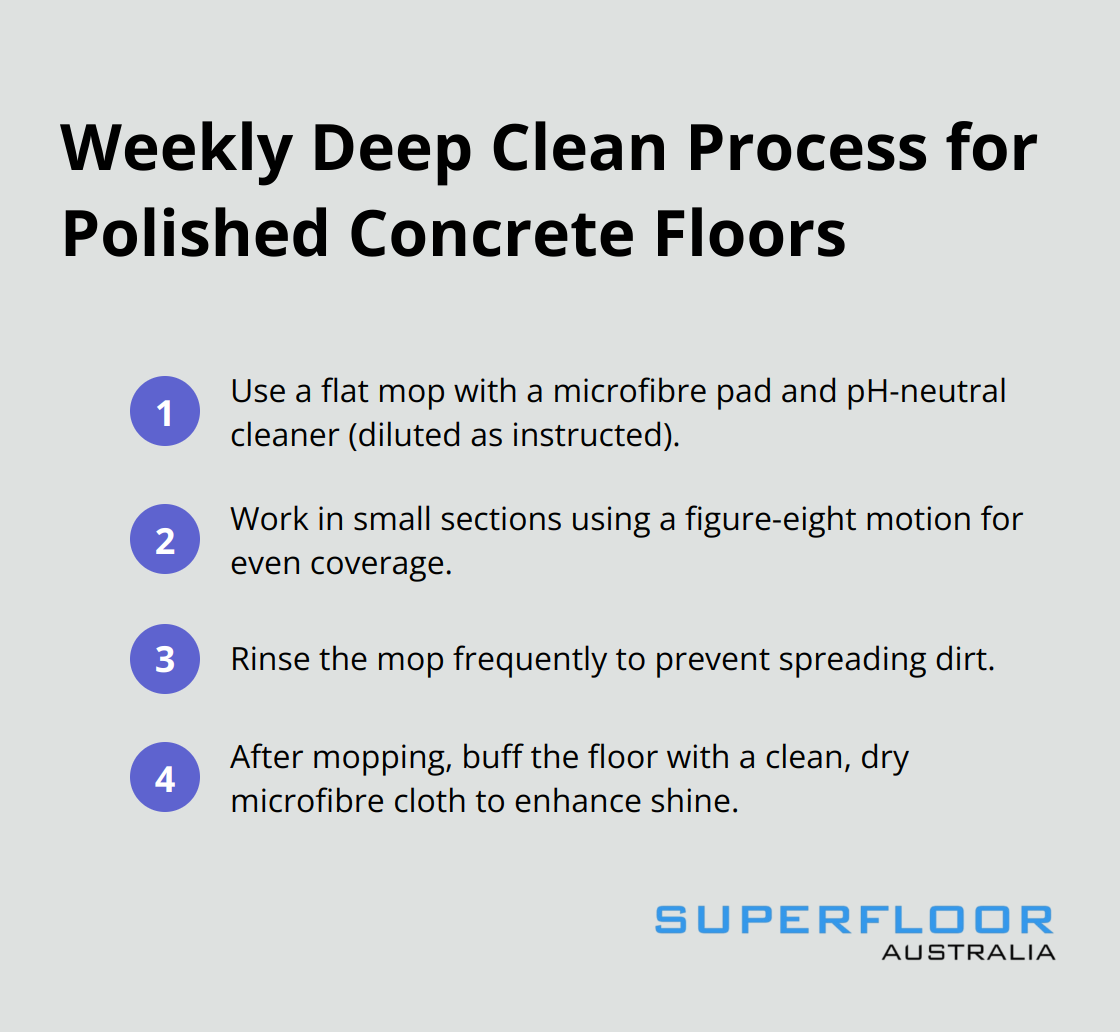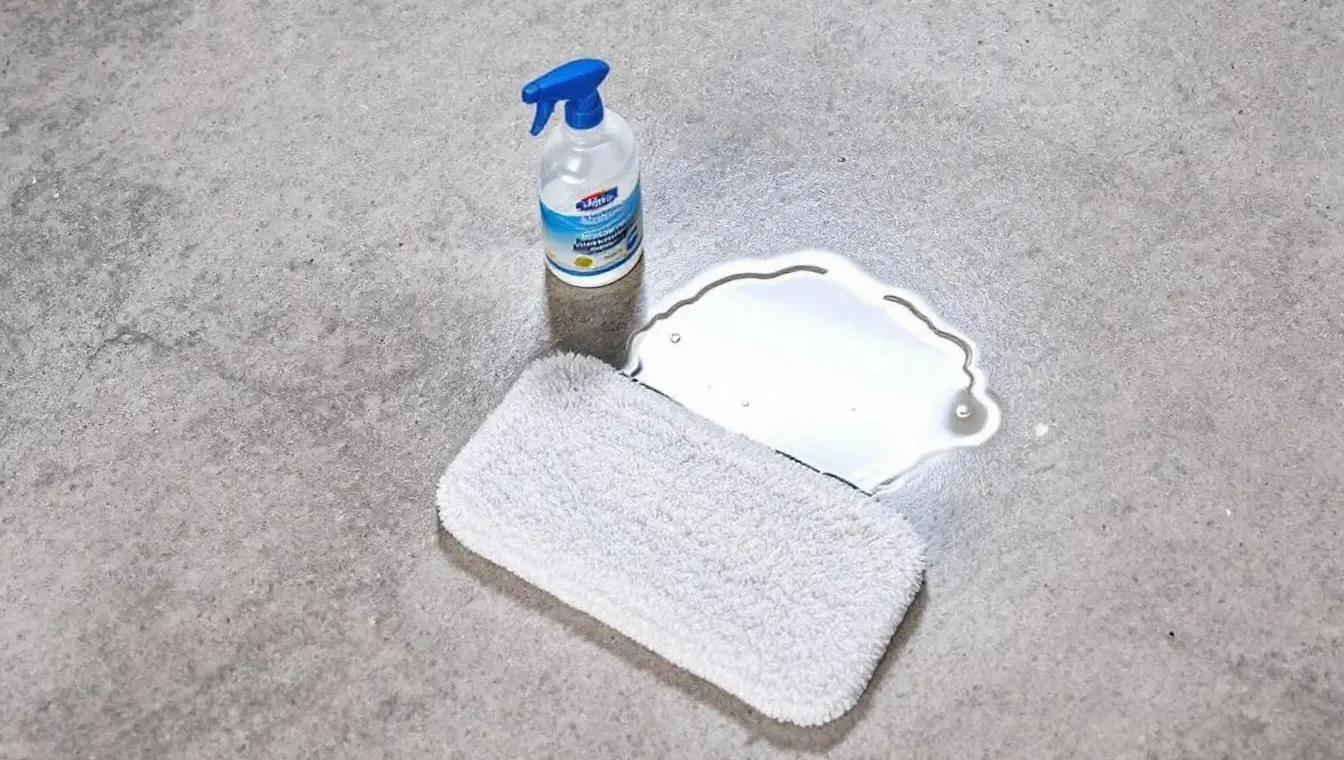Polished concrete floors are a popular choice for their durability and aesthetic appeal. However, maintaining their pristine appearance requires proper care and cleaning techniques.
At Superfloor Australia, we often get asked about the best way to clean polished concrete floors. In this guide, we’ll share our expert tips and tricks to help you keep your polished concrete surfaces looking their best for years to come.
What Makes Polished Concrete Floors Special?
The Science Behind Polished Concrete
Polished concrete floors transform ordinary concrete into a smooth, reflective surface through a multi-step process of grinding, honing, and polishing. This method creates a visually striking and incredibly durable floor. The result is a surface that resists wear and tear, maintaining its appearance for years with minimal maintenance. This makes polished concrete an excellent choice for high-traffic areas where durability is essential.
Benefits for Businesses and Homeowners
Polished concrete offers significant advantages for both commercial and residential applications:
- Cost-effective: Businesses can reduce long-term expenses due to less frequent replacement and minimal upkeep.
- Allergy-friendly: The smooth surface doesn’t harbour dust, mites, or other allergens, making it ideal for those with respiratory issues.
- Easy maintenance: The seamless nature of polished concrete simplifies cleaning, appealing to busy families and commercial spaces alike.
- Versatility: It suits various settings, from industrial facilities to modern homes, adapting to different design aesthetics.

Durability and Resistance
Polished concrete stands out for its resilience:
- Scratch resistance: Unlike many flooring options, it withstands heavy foot traffic without showing signs of wear.
- Stain resistance: Its dense surface repels most liquids, preventing stains (if cleaned promptly).
- Impact resistance: The hardened surface can withstand dropped items better than many alternative flooring materials.
Common Challenges
While highly resistant, polished concrete isn’t impervious to all issues:
- Oil and grease stains: These can be problematic, especially in garage or workshop settings.
- Scuff marks: High-heeled shoes or dragged furniture might leave marks on the surface.
- Etching: Acidic substances can etch the surface if not cleaned quickly.
Understanding these potential challenges is key to maintaining your polished concrete floor. In the next section, we’ll explore the essential tools and products you’ll need to keep your floor in top condition, addressing these issues head-on.
Essential Tools for Polished Concrete Maintenance
At Superfloor Australia, we understand that proper maintenance of polished concrete floors requires specific tools and products. This section outlines the essential items you need to keep your floors in pristine condition.
Microfibre Mops and Cloths: The Foundation of Clean Floors
Microfibre is the top choice for polished concrete care. These ultra-fine fibres capture dust and dirt particles effectively without scratching the surface. We recommend a daily sweep with a microfibre dust mop to remove loose debris. For wet cleaning, attach a microfibre pad to a flat mop head. The Concrete Polishing Association of America recommends microfibre with at least 300 GSM (grams per square metre) for optimal cleaning performance.
pH-Neutral Cleaners: Safe and Effective Solutions
pH-neutral cleaners are essential for polished concrete. These solutions clean without damaging the concrete’s surface or removing protective sealants. Select products with a pH level between 7 and 9. Avoid harsh chemicals like bleach, ammonia, or vinegar, which can etch or discolour your polished concrete.
A study by the National Floor Safety Institute found that pH-neutral cleaners reduced slip-and-fall accidents by 21% compared to other cleaning agents, making them a safer choice for high-traffic areas.

Specialised Stain Removers: Tackling Tough Spots
Stubborn stains require targeted solutions. Oil and grease stains often need a poultice or a specially formulated concrete degreaser. For organic stains (like coffee or wine), oxygen-based cleaners prove effective. Always test any stain remover on a small, inconspicuous area first to ensure it won’t damage your floor’s finish.
Protective Sealants and Waxes: The Extra Layer
While polished concrete resists stains naturally, a high-quality sealant provides additional protection. Penetrating sealers are particularly effective, as they bond with the concrete at a molecular level. For commercial spaces with heavy foot traffic, apply a sacrificial wax coating over the sealant. This wax layer absorbs daily wear and can be easily stripped and reapplied as needed.
The global concrete floor coatings market size was valued at USD 1.3 billion in 2020 and is expected to grow at a compound annual growth rate (CAGR) of 6.5% from 2021 to 2028 (according to a report by Grand View Research). This growth indicates the increasing importance of protective measures for concrete flooring.
Now that you’re equipped with knowledge about the essential tools and products, let’s explore the step-by-step cleaning process to maintain your polished concrete floors in top condition.
How to Clean Polished Concrete Floors Like a Pro
Daily Maintenance: The Foundation of Floor Care
We start each day with a thorough sweep using a microfibre dust mop. This simple step removes fine dust, dirt, and grit that can scratch the surface over time. For busy commercial spaces, we recommend two sweeps daily – one in the morning and one in the evening.
We follow up with spot cleaning as needed. We use a damp microfibre cloth to address any spills or marks immediately. Quick action prevents stains from setting and maintains the floor’s appearance.
Weekly Deep Clean: Restoring the Shine
Once a week, we perform a more thorough cleaning. We use a flat mop with a microfibre pad and a pH-neutral cleaner (diluted according to the manufacturer’s instructions). We avoid overwetting the floor – less water is better for polished concrete.
We work in small sections, using a figure-eight motion to ensure even coverage. We rinse the mop frequently to prevent spreading dirt. After mopping, we use a clean, dry microfibre cloth to buff the floor, enhancing its natural shine.

Tackling Stubborn Stains: A Targeted Approach
For tough stains, we act quickly and use the right products. Oil and grease stains respond well to a poultice made from baking soda and water. We apply the paste, cover it with plastic wrap, and leave it overnight. We then scrape off the dried poultice and clean the area with a pH-neutral cleaner.
For organic stains (like coffee or wine), we use an oxygen-based cleaner. We apply the solution, let it sit for 15 minutes, then scrub gently with a soft-bristled brush. We rinse thoroughly and dry the area.
Protective Measures: Sealing and Waxing
To maintain the floor’s resistance to stains and wear, we apply a penetrating sealer annually. This process fills the concrete’s pores, enhancing its natural stain resistance. In high-traffic commercial areas, we consider applying a sacrificial wax every three to six months. This creates an additional protective layer that we can easily strip and reapply as needed.
When we apply sealers or waxes, we ensure the floor is thoroughly clean and completely dry. We use a microfibre applicator and work in thin, even coats. We allow each coat to dry fully before applying the next or resuming foot traffic.
Professional Maintenance: When to Call the Experts
While regular cleaning is essential, professional maintenance can extend the life of your polished concrete floor. We recommend scheduling a professional deep clean and resealing once a year (or more frequently for high-traffic areas). This helps to address any wear patterns and restore the floor’s original lustre.
Professional cleaners have access to specialised equipment and products that can remove stubborn stains and restore the floor’s shine more effectively than household methods. They can also assess the condition of your floor and recommend any necessary repairs or treatments.
Final Thoughts
Polished concrete floors require a combination of daily, weekly, and periodic maintenance routines. The best way to clean polished concrete floors involves regular sweeping with microfibre mops, prompt attention to spills, and weekly deep cleaning with pH-neutral solutions. These steps prevent abrasive particle accumulation and protect the floor’s lustrous finish.
Consistent maintenance preserves the aesthetic appeal of polished concrete and extends its lifespan. Well-maintained floors retain their reflective properties, enhance interior brightness, and resist stains, allergens, and bacteria. The durability of properly maintained polished concrete aligns with sustainable building practices and reduces the need for frequent replacements.
We at Superfloor Australia specialise in high-quality polished concrete flooring solutions in Brisbane. Our expertise extends to providing guidance on maintaining your polished concrete floors (we understand that each floor has unique needs). We commit to help you preserve the beauty and functionality of your polished concrete surfaces for years to come.
